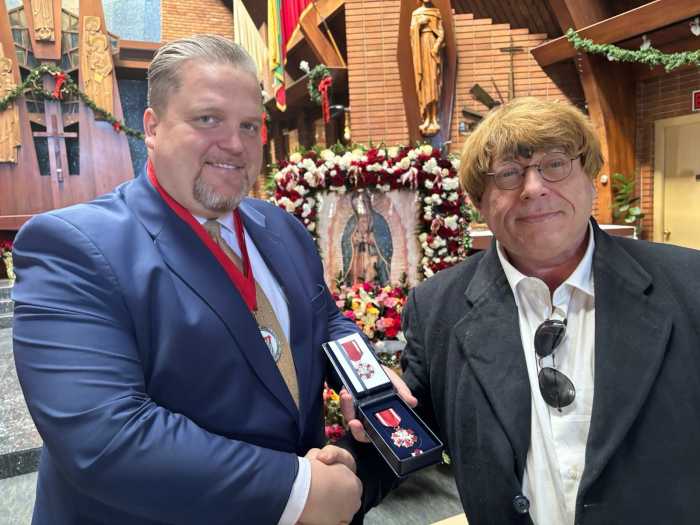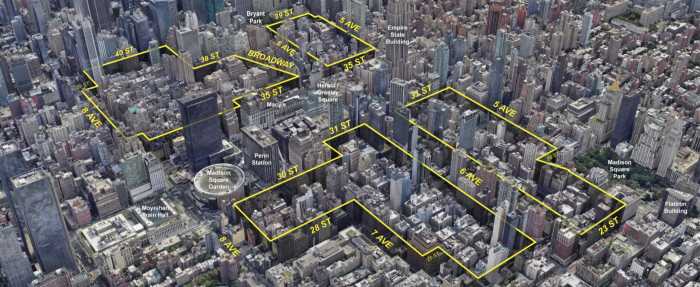By Tien-Shun Lee
After touring Briarwood houses that have sunk into the ground due to unstable underlying soil Saturday, several Queens officials expressed concern that the problem is affecting not only homes that were evacuated after they cracked in January 2001 but also houses that are now occupied.
State Sen. Malcolm Smith (D-St. Albans), who recently assumed responsibility for the sunken homes' neighborhood after redistricting, initiated the tour with Councilman Jim Gennaro (D-Fresh Meadows) and state Assemblyman Brian McLaughlin (D-Flushing) to gather first-hand information about the houses.
“I can tell you that I have never seen anything like that in a very long time, except in cases of an earthquake,” said Robert Gaskin, an architect for the Briarwood firm RCGA Architect who toured the homes around 84th Avenue and 179th Street with the elected officials.
“I saw maybe 20 houses that were cracked. The cracks went right through the building, through the brick, through the plywood framing, right into the plaster,” Gaskin said. “In some of the homes you can literally look through the crack into the house.”
Gennaro and McLaughlin have been working with the 10 families that were forced to hastily vacate their homes in January 2001 to try to decrease property taxes on their greatly devalued houses, and to secure monetary relief from state insurance funds.
So far, the two have not received positive responses from the state Department of Insurance, which says the homes are not covered because the damage was due to an act of nature. The city has not accepted blame for the sinking homes despite reports from residents of a water main in their neighborhood that broke the week they first noticed the cracks.
“I'm very, very concerned from what I saw,” Smith said. “It's a lot more serious than what I thought. One of the houses had a porch that was sloping downwards at 20 degrees.”
Gennaro said the houses in the area could be broken down into three categories: five two-family houses that suffered structural damages so severe that they had to be evacuated; five other houses that were officially identified by the city as damaged but not evacuated; and a third category of houses that have not been officially inspected but are in fact damaged.
Gennaro said he did not know how many houses in the area belonged to the third category. He, McLaughlin and Smith are currently organizing a meeting of all area homeowners and various city agencies, including the Department of Buildings and the Department of Environmental Protection, where he hoped people would let officials know about what was going on in their homes structurally.
“Some residents may be reluctant to come forward to have their home inspected because they are fearful that the Buildings Department is going to force them to vacate, and they don't want to suffer the fate of their neighbors,” Gennaro said. “We are very concerned that people out there are suffering damages and not letting us know.”
According to Gennaro, families that were forced to vacate have been living with relatives or renting apartments for the past two years while continuing to pay taxes on their damaged homes. They are in litigation with the city and have received no monetary aid from the city, the state or insurance companies.
To add insult to injury, some homeowners were charged fees by the DEP for turning off their water service and billed by the Environmental Control Board for not keeping their property clear of debris, even though they were forbidden by the city to go back on their property.
The DEP and ECB fees were dropped in December after pressure from homeowners' lawyers and Gennaro.
Gaskin said he did not believe the people living in the homes with cracks in their walls were in immediate danger, but the homes still should be monitored for crack sizes and movement.
“You can't just put silicon in the cracks. About 40 percent of the homes that I saw you would have to do full replacement – knock down sections of the home,” he said. “The first thing that should be done is some type of geological evaluation should be made.”
Though numerous soil-boring tests have been made, it is still unclear exactly what caused or is causing the soil to shift.
“We don't want people to panic, but something has to be done quickly,” Smith said.
Reach reporter Tien-Shun Lee by e-mail at Timesledger@aol.com, or call 718-229-0300, Ext. 155.



































